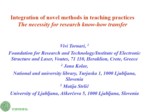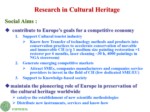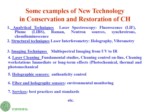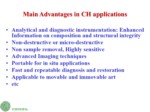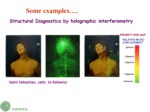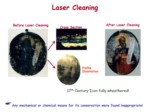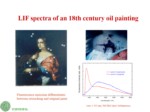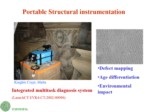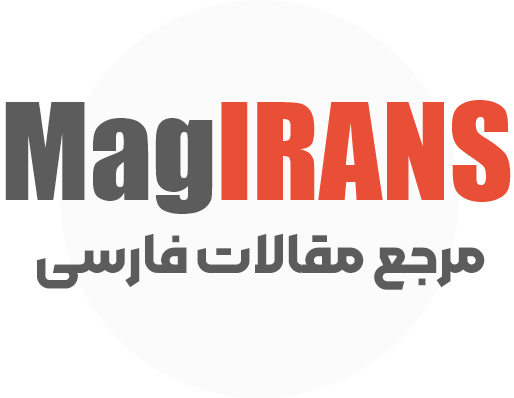بخشی از پاورپوینت
--- پاورپوینت شامل تصاویر میباشد ----
اسلاید 1 :
Research in Cultural Heritage
ucontribute to Europe’s goals for a competitive economy
1.Support Cultural tourist industry
ØKnow-how Transfer of technology methods and products into conservation practices to accelerate conservation of movable and immovable CH (e/g 1 medium size painting restoration =1 restorer per 6 months, laser cleaning ~30 h, 4000 paintings in NGA storeroom)
2.Generate emerging competitive markets
ØAttract SMEs, companies manufacturers and companies service providers to invest in the field of CH (few dedicated SME/EU)
3.Support to Knowledge-based society
umaintain the pioneering role of Europe in preservation of the cultural heritage worldwide
Øcatalyse the establishment of new scientific methodologies
ØDistribute new instruments, services and know-how
اسلاید 2 :
Some examples ofNew Technology
in Conservation and Restoration of CH
- Analytical TechniquesLaser Spectroscopy: Fluorescence (LIF), Plume (LIBS), Raman, Neutron sources, synchrotrons, chemiluminescence
- Structural techniques Laser Interferometry: Holography, Vibrometry
- Imaging Techniques Multispectral Imagingfrom UV toIR
- Laser Cleaning Fundamental studies, Cleaning controlon-line, Cleaning workstations Immediate or long-term effects (Photochemical, thermalandphotomechanical
- Holographic sensors: authenticity control
- Fiber and holography sensors: environmental monitoring
- 7. Services: best practices and standards
etc.
اسلاید 3 :
Main Advantages in CH applications
- Analytical and diagnostic instrumentation: Enhanced Information on composition and structural integrity
- Non-destructive or micro-destructive
- Non sample removal, Highly sensitive
- Advanced Imaging techniques
- Portable for in situ applications
- Fast and repeatable diagnosis and restoration
- Applicable to movable and immovable art
- etc
اسلاید 4 :
Some examples….
Structural Diagnostics by holographic interferometry
اسلاید 5 :
Laser Cleaning
اسلاید 6 :
LIF spectra of an 18th century oil painting
اسلاید 7 :
Portable Structural instrumentation
اسلاید 8 :
Established University courses addressing CH are primarily linked to architecture and civil engineers schools !!!
The rare and spread approval for EC funded courses (e.g RAPHAEL) is fragmented
Rare SMEs organized courses are expensive and for limited number of students
How many conservation students can be updated on research results and how
How many schools around Europe exist for such a purpose
How many conservation departments are equipped with relevant teachers or training laboratories and why not
اسلاید 9 :
Roadmap for Social impact of
Know-how transfer
- Educational Training familiarises endusers with novel methods/technology results
- Familiarised users request frequent updating
- Requests create demands
- Demands create new markets
- New markets attract or create SMEs
- SMEs investment attract or create new research
- Research boosts economy growth
- Economy growth in CH safeguards preservation
Recent Examples: -COST G7 Workshop Ljubljana 2005 80 applicants
-Project Demo Laseract Paris 2006 ~110 applicants
اسلاید 10 :
Recommendations
- Apply mechanisms for research dissemination to CH organisations
- Enhance dissemination of products/services to SMEs
- Funding for new methods into courses and teaching practices
- Training in research results for both tutors and students
- EU funding should require tangible research results and in turn explore and invest on them (patents, spin-offs, programs,….)
- Funded Research perspectives being put by networking committees of involved scientists and technology providers
- Education providers and Endusers being regularly updated and informed by EC dedicated programs in pan-European level

